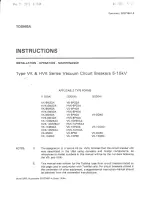
PSXX Manual Rev: A Software Rev: F
17
CV55
Block Current Trip Hysteresis
●
Default = 4.
●
The Block Occupied output will turn ON when the detected current is more than
the sum of CV54, CV55 and CV56.
●
In general, this value should not be adjusted unless the Block Occupied output is
chattering on and off.
CV56 Average Unoccupied Block Current
●
Default = 27, acceptable values 1 - 255.
●
The average value of the current in the block that is just below the trip level.
●
The value may be set manually as required
●
Note: the current input uses a nonlinear function, so manual setting is by trial and
error) or automatically using CV53.
●
Any current above this value may cause the Block Occupied output to turn ON.
●
When set automatically, a resistance of 3.3K will add enough current above the
background to turn the Block Occupied output on.
●
Increasing the value will increase the current required in the block to turn the
Block Occupied output on.
CV63 initiates a PSXX Factory Reset.
●
Using the Program On Main
programming mode of your DCC system, set CV63=42.
●
You will see D6 flash.
●
After D6 flashes, all CVs and addresses are returned to their original factory
values.
●
The CV63 default is 0. Setting CV63=42 will not change the CV value, but it will
reset the PSXX.
CV66
controls how the PSXX outputs power to the track when the associated booster is
turned on.
●
Default=1
●
CV66=0 The PSXX J2 output will always be OFF after the booster powers up. This
is useful for staging and storage yards or similar layout sections where there is no
point in using booster power for equipment that will not be running. When needed,
the PSXX is turned ON by an Accessory Command.
o
If a photocell is connected and CV50=0, then the photocell will always be
calibrated and disarmed. It will only control power output.
o
If a photocell is connected and CV50=1, the photocell is enabled to control both
the PSXX power output and the PSXX Block Occupied output. With this option,
the photocell remembers its calibration at booster shutdown so that the next
power on session it will correctly identify if the block is occupied [photocell
covered] or not [photocell uncovered]. The photocell is NOT calibrated and is
disarmed
o
If CV50=1, Block Occupied will flash when the photocell is armed. It will become
steady [on without flashing] when the photocell is covered and the PSXX output
is switched OFF [stopping train over photocell; Block Occupied indicating
OCCUPIED].
●
CV66=1 The PSXX output will always be ON after the booster powers up.







































